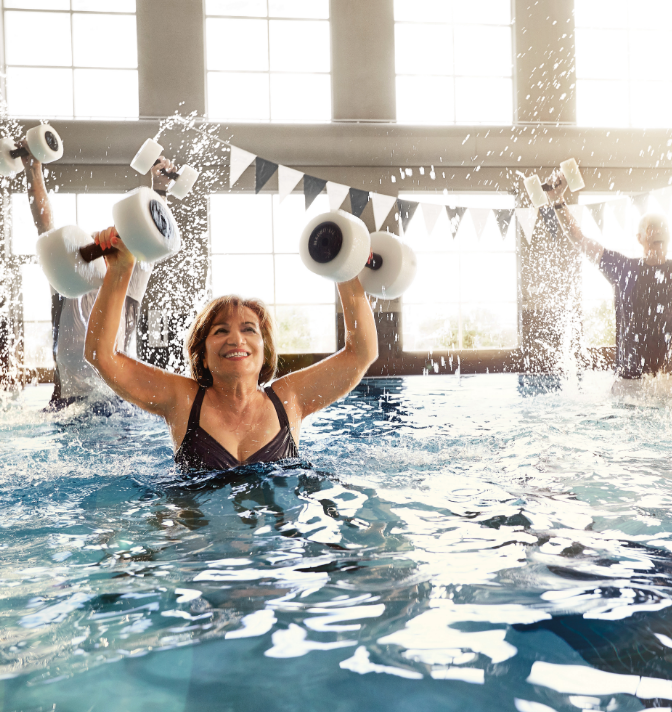You often hear the importance of exercising your body, but exercising the brain is also crucial — especially for healthy aging.
“Like any other muscle in your body, with your brain, you either ‘use it or lose it,’” says Rob Glick, senior director of group fitness programming and innovation and creator of several ARORA programs for Life Time. “Keeping your brain engaged and consistently rewiring itself is key to both your long-term cognitive functioning and overall well-being.”
What Is Neuroplasticity?
The brain is always adapting — whether you’re learning something new or having a novel experience. Sometimes the brain needs to re-learn things too, like after an injury or a stroke.
“Neuroplasticity is the capacity of the nerve cells in your brain to adapt to different circumstances,” Glick explains. “These cells respond to stimulation by generating new synapses and making connections, which result in functional changes to the brain.”
But when the brain is deprived of learning or experiences excess stress, these neural connections can weaken over time.
“This adaptation is essential to cognitive function and overall quality of life,” says Glick. “I like to think of it like this: If I’m driving to a place I’ve never been, I need to focus. The new roads are being laid out in my brain — making connections and expanding my knowledge. But once I’ve driven to that place a few times, I no longer need to pay as close of attention — and my brain is no longer making connections. For our brains to continue growing, we regularly need new mental challenges.”
Why Is Neuroplasticity Important for Healthy Aging?
Most of us are aware that certain lifestyle habits like moving our bodies and eating mindfully can help us live healthier as we age — and continuous learning can help keep our brains strong.
A recent study showed that there are five lifestyle behaviors notably connected to slowed memory decline in older adults: A healthy diet was the most powerful deterrent, followed by cognitive activity and physical exercise. The other two habits included refraining from smoking and alcohol use. This was found irrespective of ApoE4 status (a genetic variation that makes an individual more likely to develop Alzheimer’s disease).
“Creating new pathways in your brain may help mitigate cognitive and motor decline symptoms associated with aging,” says Glick. “It can also help address common aging issues, including balance, spatial awareness, tracking, and reasoning.”
How Can I Improve My Neuroplasticity?
The word “neuroplasticity” may make it sound complicated to approach, but Glick maintains that helping our brains stay active and strong can be simple. “Keep trying new things, new challenges — and your brain will thank you,” he says.
Glick offers the following examples of ways you can do this, some of which are incorporated into the various ARORA classes and programs at Life Time.
1. Meet someone new.
Creating new connections in your brain can be as easy as meeting someone new and learning their name. Plus, social bonds and interactions are critical for our health.
“In our ARORA classes, we try to build community — and our memories — by learning everyone’s name in class, if possible, so we can form those connections” says Glick.
(Learn more: “Which ARORA Class Is Right for You?” and “How to Meet a Workout Partner — and Be a Better One Yourself”)
2. Dance to music.
Dance and coordinated movements to music can create synapse growth in the brain.
“Research shows that one of the best ways to improve neuroplasticity is through movement patterns to music,” he says. “New movement patterns, music patterns, and the act of listening all come together for increased brain cell connections.”
If this sounds fun to you, Glick suggests trying ARORA Dance, as it combines music with an easy-to-follow, dance-based cardio workout.
(Learn more: “Why Dance?”)
3. Play memory games.
Exercising your brain can be as simple as playing games or learning new fun facts.
“Our ARORA class instructors sometimes facilitate memory games where, for example, we have our participants memorize a sequence of five new words,” says Glick.
“The instructors also like to find out something unique to share about today’s date,” Glick says. “For example, on National Herb Day in May, we talked about five facts about herbs and had fun quizzing participants throughout class on what they learned.”
Game Boxes are also available in all Life Time locations as part of the ARORA offering, so members can play them with others in their community.
4. Try a new activity.
A new hobby. An easy-to-learn sport like pickleball. A new language or instrument. An adventure traveling to a new place. Think about something that interests you or that you’ve always wanted to do — and try it! These novel experiences push you out of your comfort zone and get the neurons in your brain to fire in new ways.
5. Rest and reduce stress.
Stress and a lack of sleep can decrease your overall cognitive functioning, so two of the best things you can do for your brain are prioritize high-quality sleep and mitigate stress. Sleep supports many aspects of cognition, including memory, problem solving, creativity, and emotional processing.
Meditation is linked to both reduced stress and increased neuroplasticity. If you’ve haven’t tried it yet, you can learn a new skill while also calming your mind. To start, try these “Meditations for Your Moods.”





